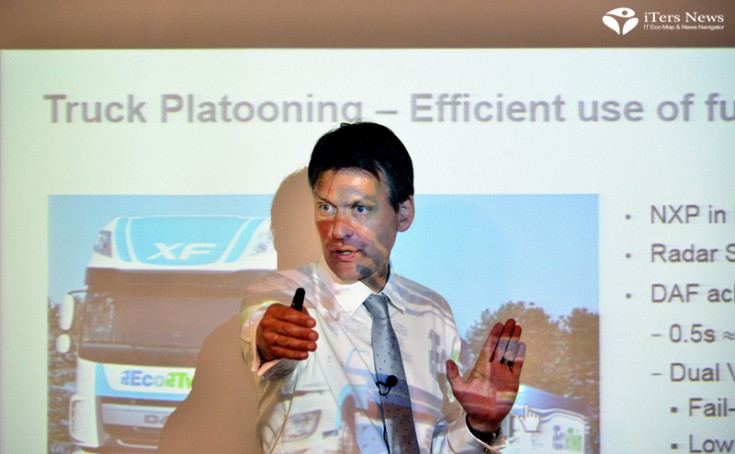Fleet of cars communicate with traffic lights: Are you green or red ?
Car drivers can communicate with cars several l cars apart racing ahead and even talk with road infrastructures like traffic light systems at the intersection and road monitor camera system or CCTVs to get alerted of what’s going on the road ahead or get knowledge on
The test-run service started with July 2016 and will stay effective through July 2017.
At the center of what’s called as CITS is eSSys Co. Ltd.’s wave communications solution module that comes built with NXP Semiconductors’ RoadLink chipset.
The RoadLink chipset is a board-level concentration of a multi-standard software-defined, or SDR radio transceiver and 802.11p baseband chip, i.MX applications processor chip, software stacks from Coda Wireless, security sacks and other peripherals like Ethernet on a board to support IEEE 802.11p car to car or car to infrastructure Wi-Fi communications.
The 802.11p car Wi-Fi technology is sort of software- defined so that they allow system vendors or chip maker to reprogram the software radio stacks depending on their home country’s radio standards.
Designed to power vehicle to vehicle or vehicle to infrastructure communications, the 802.11p car Wi-Fi technology is different from consumer Wi-Fi technologies at home and in office in its sensing and bi-directional communications ability. It also satisfies car industry’s stringent system requirements for rugged outdoor uses. The technology boasts of lower data latency, too, staying fast enough to communicate in real time.

The technology advances translate into appealing use cases of the RoadLink chipset on C-ITS service. For one thing, the system can warn drivers of traffic hazards looming a few seconds away or even one mile ahead.
“What can be use cases? It’s very simple. Its’ Do not pass” warning signal for motorcycles. This is important for me and more important for guys on the motorcycle. I am behind a truck, and want to pull out to overtake it, and am getting the warning already behind the truck. “Lars, do not take that stupid thing. There is a fast motorcycle approaching you. Okay, I will stay on my lane. This is communication with (a motorcycle) on the outside land out-of sight. No human beings, no radars, and no cameras can do that, because, this is “outside lane out of sight,“ Lars Reger, CTO with the automotive business unit of NXP Semiconductors.
Seeing throughout obstacles is another possible use case that allows car drivers to see road obstacles two or three cars ahead and get a warning signal on it.
Car drivers also can see around themselves not only getting alerted of pedestrians crossing a road around a corner or am emergency ambulance coming roaring, which otherwise risk colliding against each other. “ If my car gets a warning, it can calculate the point of collision and put on a brake early on (to avoid collisions),” explained Lars.
The most interesting use case is what is called as a truck platoon system, or a cooperative driving, under which trucks are racing together in a complete sync mode 11meters apart from each other at an upward of 80km per hour using the RoadLink chipset and a collection of radar chip systems.

Led by a lead driver who sits on the first truck on the synced system, for example, the cooperative truck driving synchronizes the driving of trucks on the wireless network leaving other drivers off hand just sitting on their drivers’ seats.
Assuming that the lead driver slams on the brake or slow down his truck speed to avoid abrupt road blocks or stop at the intersection, the system sends stop and braking signals across the trucks in the wake to do the same action.
It will take just half a second for all trucks in the wake to slam on brakes simultaneously keeping always 11 meters distant from each other and then comes to an abrupt stop. It is amazing far faster than what it takes human car drivers to find road blocks and then get into action to slam a brake to stop it. .
“The first truck can negotiate with the traffic light saying “I am loading the 5 trucks in queue. Don’t slow down me. Keeping the light green, and otherwise it will create a traffic jam. Less noise, less pollution and overall smooth traffic flow through all of the city, “ said Lars Reger, CTO with the automotive business unit with NXP.
For example, the lead truck driver finds obstacles on the road and slam on a brake, and then the first truck sends the braking messages across the fleet of trucks in the wake. They receive, decode, verify. It takes 3 to 5 milliseconds to complete all these. And then they send the message to each of the braking system to lock the wheels. It takes less than half a second to complete all the processes from start to finish.
For human beings, it takes 1 second to recognize the brake light coming off the car in front and then they put on the brake to react. It will take at least 1.5 seconds.
The V2X chipset-based cooperative driving system and ITS service is actively tested across the world for the full deployments. In Japan, Toyota had embedded the V2X chipsets into its Pruis 2015 line-up using Japan’s 760MHz rapid frequency network. In Singapore, the V2X chipset –based ITS system is under test for the commercial rollout in 2018. China is undergoing its own evaluation test for the deployment, too.
After the test-run service is completed, Korea is scheduled to full deploy the ITS service in early 2018 to be timed with the opening of the Pyeongchang Winter Olympics Games.
European countries like Austria and Netherlands are conducting a corridor test drive using the V2X technology. The U.S. Department of Transportation joined forces with NXP Semiconductors to test the V2X-based smart driving system as part of its Smart City project.